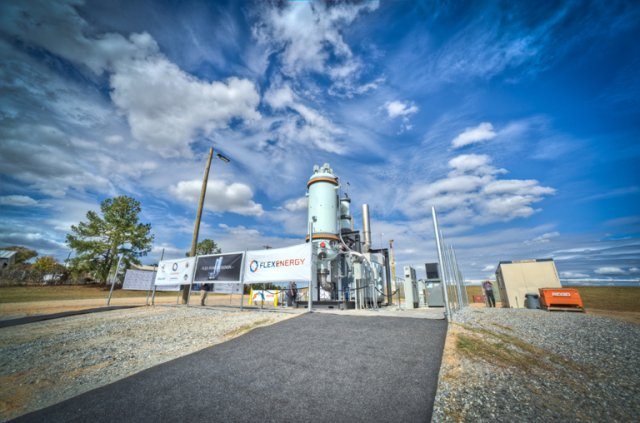Army, government and private industry leaders came together last week to celebrate the startup of a system at Fort Benning’s landfill designed to capture methane and convert it to electricity.
FlexEnergy Inc. has successfully installed its first commercial order of the Flex Powerstation FP250 on Harmony Church. Officials said the Southern Research Institute selected the power station under a demonstration program funded by the Department of Defense’s Environmental Security Technology Certification Program, which seeks innovative and cost-effective methods to address environmental and energy priorities.
A ceremonial ribbon cutting took place Nov. 8 at the site.
“It’s an opportunity for us to promote and develop clean, renewable energy,” said Col. Jeffrey Fletcher, the garrison commander. “This collaboration represents a very important step and promises a more sustainable energy future. It shows Fort Benning has a true commitment and pledge toward environmental stewardship.”
The power station will turn venting gas from the landfill into enough renewable electricity to power the equivalent of 250 homes a year, said Stephen Johnson, with FlexEnergy. The project’s price tag was about $1 million.
“Yes, I am excited to be on a landfill demonstrating a fantastic technology. We are witnessing sustainability in action,” Johnson said. “We’re taking waste gas and converting it into energy and electricity with virtually zero emissions from harmful greenhouse gases. It’s exciting. We’re helping to deliver environmental protection, energy and national security, and economic prosperity.”
The plant could be refined to a “pollution control device” that potentially pays for itself in less than six years, Johnson said. By comparison, the payback on an average windmill takes as long as three decades.
Richard Kidd, deputy assistant secretary of the Army for energy and sustainability, said the branch spent almost $4 billion on energy during fiscal 2010. The Army is the largest consumer of electricity within the entire federal government, and most of it’s expended at the installation level.
“Our electric bill captures all the challenges our federal government has to meet — and then some,” he said.
Today’s Army must make decisions to preserve land, water and resources, Kidd said, adding it’s “mission critical” for operations at home and overseas. It has more than 140 renewable energy projects under way.
“The challenge for the Army is to ramp these up and make them a more prominent feature on our installations,” he said.
The new power station will account for only about 1 percent of the post’s electrical supply, but it’s a start, said Fort Benning Energy Manager Vernon Duck. The Energy Policy Act of 2005 now requires all government installations to use or consume at least 5 percent of their electricity from “green energy” resources. That mandate will go up to 7.5 percent in fiscal 2013.
He said Fort Benning isn’t meeting the mandate now — actual “green power” production here is 0.71 percent, but the reported figure is 1.41 percent. By law, military bases may double their reported output if the energy source sits on installation property. It’s aimed at getting government facilities to seek alternatives by investing more in “green energy” solutions, he said.
Duck said this unique waste-to-energy solution delivers on the growing promise of renewable energy’s integration into the power grid.
“Fort Benning is aggressively seeking ‘green energy’ alternatives to put in place on the installation,” he said. “We will use the clean electricity generated on-site to power our internal operations and help reach the DOD’s energy independence, renewable energy and sustainability goals.”
With the military facing constrained budgets in the future, this brand of innovation will reduce the Army’s carbon footprint and bottom line while enhancing energy security, efficiency and independence, said Jeffrey Marqusee, the ESTCP head and executive director of the Strategic Environmental Research and Development Program.
“It’s a great testament this thing is up and operating — it’s something we can bring to other installations,” he said. “We think this is one of many partnerships we’ll have between DOD, our installations and the private sector.”
The new power station finished initial operations tests in mid-August, producing up to 250 net kilowatts of renewable energy, according to a news release. After a final set of landfill operation integration evaluations over the next two weeks, the system will generate renewable electricity full time.
As part of the installation test bed program, the Southern Research Institute will verify system functions, measure environmental and energy benefits, and document the company’s track record.










